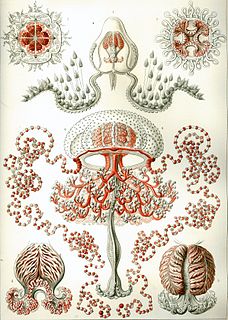
Hydrozoa are a taxonomic class of individually very small, predatory animals, some solitary and some colonial, most living in salt water. The colonies of the colonial species can be large, and in some cases the specialized individual animals cannot survive outside the colony. A few genera within this class live in fresh water. Hydrozoans are related to jellyfish and corals and belong to the phylum Cnidaria.

Anthoathecata, or the athecate hydroids, are an order of hydrozoans belonging to the phylum Cnidaria. A profusion of alternate scientific names exists for this long-known, heavily discussed, and spectacular group. It has also been called Gymnoblastea and, Anthomedusa,Athecata, Hydromedusa, and Stylasterina. There are about 1,200 species worldwide.

Aequorea forskalea is a species of hydrozoan in the family Aequoreidae. Discovered in 1810 by Péron and Lesueur, A. forskalea was initially found in coastal to offshore waters of the Mediterranean Sea. This species is commonly referred to as the many-ribbed jellyfish. The species is often mixed up with some other members of the genus due to some similarities including the capability of bioluminescence.

Crossota is a genus of hydrozoans of the family Rhopalonematidae. The genus comprises five species. Unlike most hydromedusae, these do not have a sessile stage. Rather, they spend their entire lives in the water column as plankton. The genus Crossota is widespread throughout the oceans.

Rhopalonematidae is a family of hydrozoans. The family comprises 15 genera and 36 species.

Vampyrocrossota is a genus of hydrozoans of the family Rhopalonematidae. The genus only contains one species, Vampyrocrossota childressi. Unlike many hydromedusae, these animals do not have a sessile stage. Rather, they spend their entire lives in the water column as plankton. It is the only known species with a medusa that is truly black.

Benthocodon is a genus of hydrozoans of the family Rhopalonematidae. The genus contains two known species: Benthocodon hyalinus and Benthocodon pedunculatus, however due to the small size and red pigmentation, they can easily be confused with related genera. Unlike many hydromedusae, these jellyfish do not have a sessile stage. Rather, they spend their entire lives in the water column as plankton. The genus Benthocodon can be found near the sea floor in the Pacific Ocean from Antarctica to California to the Arctic Ocean.
Pantachogon is a genus of hydrozoans of the family Rhopalonematidae. The genus includes three species.
Voragonema tatsunoko is a species of deep sea hydrozoan.

Aglantha is a genus of deep-sea hydrozoans of the family Rhopalonematidae.
Arctapodema is a genus of deep-sea hydrozoans in the family Rhopalonematidae.
Amphogona is a genus of deep-sea hydrozoans of the family of Rhopalonematidae.

Aglaura is a monotypic genus of deep-sea hydrozoan in the family Rhopalonematidae. It is represented by the species Aglaura hemistoma.

Persa incolorata is a species of deep-sea hydrozoan found in the monotypic genus Persa in the family Rhopalonematidae.

Rhopalonema is a genus of deep-sea hydrozoans of the family Rhopalonematidae.

Sminthea is a genus of deep-sea hydrozoans of the family of Rhopalonematidae,
Tetrorchis is a monotypic genus of deep-sea hydrozoan in the family Rhopalonematidae. It is represented by the species Tetrorchis erythrogaster.
Crossota alba is a species of hydrozoan in the family Rhopalonematidae. this species does not have sessile stage as other hydromedusae. Crossota is spread all over the ocean and lives their life in water as plankton. Crossota alba are commonly distributed in the west coast waters of India.

Colobonema sericeum is a species of deep-sea hydrozoan in the family Rhopalonematidae that was first described in 1902. This semi-transparent organism is found in the mesopelagic zone, has 32 tentacles, and has a bell diameter of up 45 mm. They are holoplanktonic and never attach to the seafloor as part of their polyp life cycle, but instead have embryos that develop directly into a small, swimming medusae.













